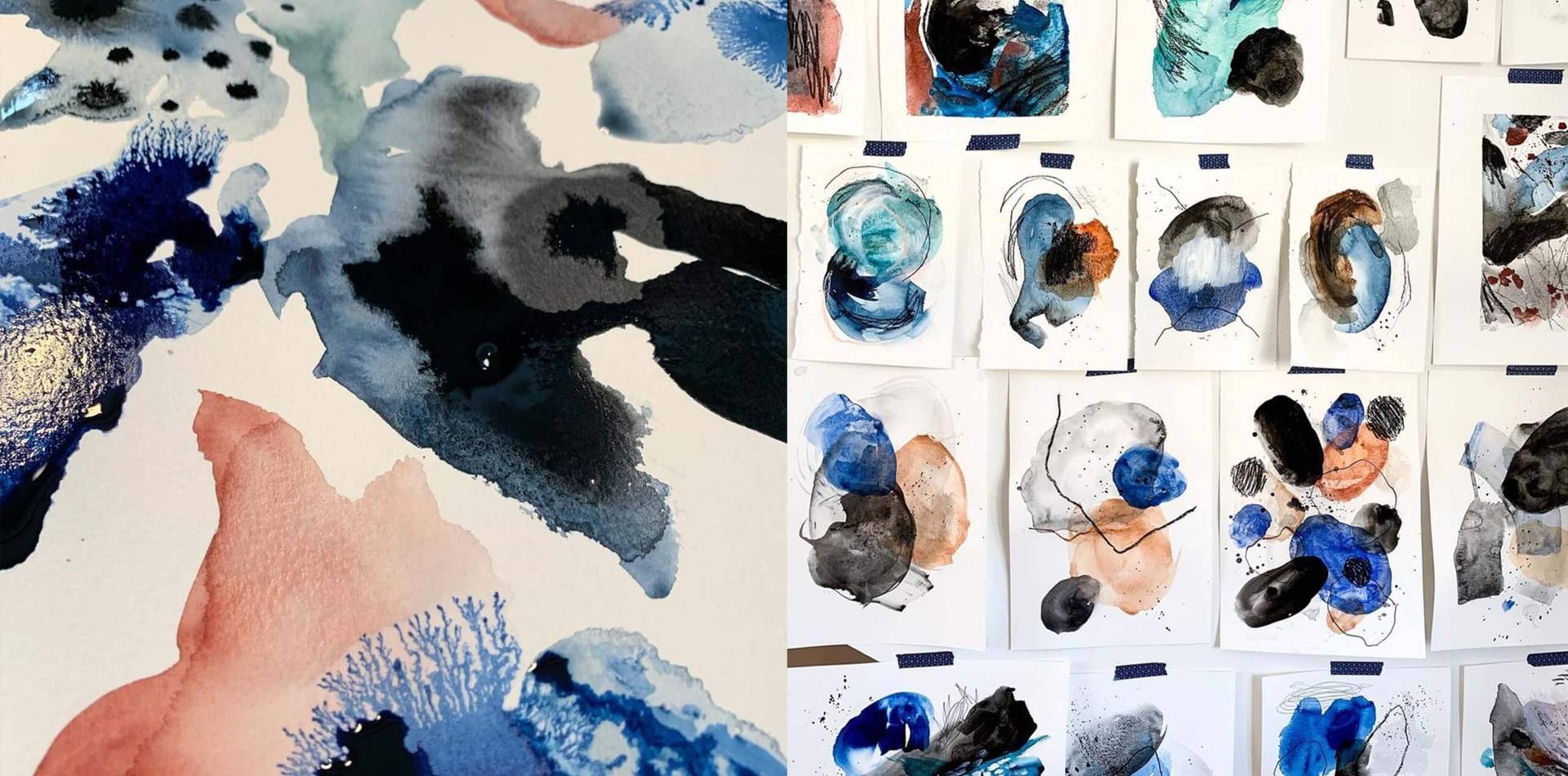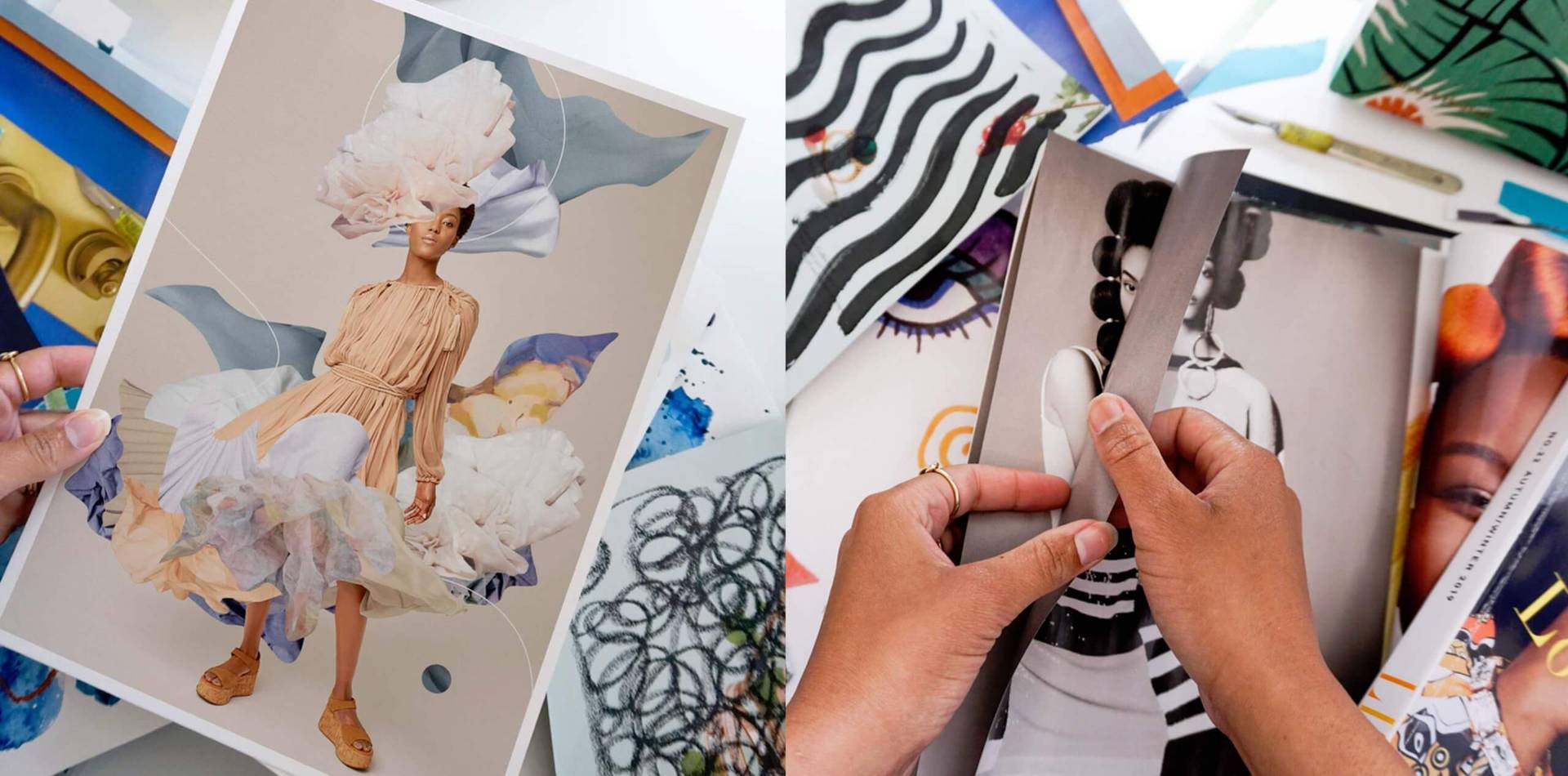Ciara Phelan is co-founder and Creative Director of illustration agency Grand Matter, a founding member of diversity platform Agents for Change and has recently been appointed Board Director of the Association of Illustrators. With a background in design, Ciara established herself as successful mixed media collage artist, with previous clients including Design Week, the V&A, Vogue and The New York Times.
Throughout her career as an illustrator, Ciara worked continuously on self-initiated side projects, enjoying the challenge of coming up with ideas and collaborating with others to realise them. These ventures eventually culminated in the launch of the illustration agency, Grand Matter, founded with creative producer Dorcas Brown.
Setting up a women led agency presented many challenges, particularly the personal challenge of self-confidence. Ciara often found herself working with men in senior positions and struggled to have her voice heard. However, as Grand Matter has become more established and its reputation spread, she has become less worried about what people think. This has enabled her to develop a more confident voice and take control of situations: “I think it comes through experience, but also the fact that I became a mum two years ago. I simply don’t have the brain space to ruminate on social interactions the way I used to, it’s quite refreshing and freeing.”

Ciara struggles to quantify how being a woman of colour has affected her career. She remarks that while that she has not experienced overt racism within the industry, she has faced many situations where she has felt overlooked or unheard in client conversations. Ciara attributes this attitude partly due to the fact she is a collage artist, but also because she is a woman. Recently this has started to shift, as she tells us, “I’ve found this has changed, especially as Grand Matter has grown and I have become more fearless with my opinion, I feel I have something to say, and people want to listen.”
“…as Grand Matter has grown and I have become more fearless with my opinion, I feel I have something to say, and people want to listen.”
In the wake of the Black Lives Matter protests, Ciara spearheaded founding platform Agents for Change alongside other illustration agents in the creative industry. Despite having championed diversity throughout her career, she began reflecting more upon the challenges she herself has faced due to her ethnic background, gender, and socioeconomic status. She realised that she wanted to do something bold and meaningful to promote “active inclusion”. A year later, Agents for Change is a thriving platform engaging with artists from under-represented groups, offering many services including mentoring, portfolio reviews and guidance.
We talked with Ciara to find out more about setting up an agency, her new role as the Director of the Association of Illustrators and the role design has in influencing social change.
Can you tell us about where your career began and why you decided to become a visual artist?
I’ve wanted to be an artist since I was very young. I was extremely lucky to be brought up in a very creative family. My grandmother was a seamstress, my grandfather a carpenter and my mother loved textiles and antiques. Art and creativity were all around me and so I naturally developed a passion for them. Throughout my childhood, I would spend hours drawing, painting and collaging; it was my safe space to go to when the world was tough and as I grew older, this passion developed into a career.
What led you to take the plunge and set up an illustration agency with Dorcas Brown?
Whilst working as an illustrator I was always developing side projects as I enjoyed the challenge of conceiving an idea and then working with others to realise it. Initially I ran an online gallery where a collective of illustrators sold artwork. Then I launched a homeware brand called Kith & Kin for which I designed ethical textiles and stationery. After a few years of these side hustles, I decided to work in a business that brought these passions together and launching an agency seemed like a natural step as it brought together my love of illustration, collaboration, and initiating projects and exhibitions.
“After a few years of these side hustles, I decided to work in a business that brought these passions together and launching an agency seemed like a natural step.”
How has Grand Matter evolved to what it is now and have there been any pivotal moments?
When we first started Grand Matter, we had five artists; over the last four years we have grown to eighteen – which feels crazy. We’ve learnt so much during this time. We’ve had a crash course in cash flow and turnover, we’ve dealt with lawyers, had artist leave us, had staff join us and most recently dealt with Brexit and the pandemic. The main thing I have learnt is to take a breath and breathe, for every problem there is always a solution.
“The main thing I have learnt is to take a breath and breathe, for every problem there is always a solution.”
What was it like setting up an agency as two women in business and what challenges did you face?
The biggest challenge for us has been controlling our inner self-saboteur and building confidence. We often work with men in senior positions and at times it has been a struggle to have our voices heard. But as time as gone on, I’ve noticed that I worry less and less about what people think and that has enabled me to become more confident in speaking my mind and taking control of a situation. I think it comes through experience, but also the fact that I became a mum two years ago. I simply don’t have the brain space to ruminate on social interactions the way I used to; it’s quite refreshing and liberating.
“…I became a mum two years ago… I simply don’t have the brain space to ruminate on social interactions the way I used to, it’s quite refreshing and freeing.”
We’re very excited by your inspirational new initiative Agents for Change. What is the impetus behind the platform and what do you hope to change in the creative industries?
The catalyst for launching Agents for Change was the Black Lives Matter protests and sharing of the black squares on social media. I had always been keen to champion diversity but the space in our lives created by lockdown gave me a chance to really reflect on my own journey and the challenges I have faced due to my ethnic background, socioeconomic status, and gender. I decided I wanted to do something bold and meaningful, hopefully something that would have a lasting legacy. Through Grand Matter I reached out to other agents in the industry and invited them to discuss what we might achieve collectively.
Now over a year later we have a thriving platform where we can engage with artists from under-represented groups. We’re hoping to improve paths for those making their way into the industry by providing mentoring and guidance. We want to demystify the creative industry through talks, events and educational resources. We want to make diversity a priority within our rosters of artists and our teams by conducting and publishing a yearly diversity survey mapping our combined rosters of artists.
“We want to make diversity a priority within our rosters of artists and our teams by conducting and publishing a yearly diversity survey mapping our combined rosters of artists.”
You’ve also very recently been appointed a Director for the Association of illustrators. Congratulations! What will your new role involve?
I am so thrilled and honoured to join the AOI as a board director. The organisation has been pivotal in my career by providing support and guidance when I was entering the industry so to be asked to help shape the direction of the company is a dream. My role on the board is to help provide both an artist and a client perspective as I deal regularly with both and so have a nuanced understanding of the challenges faced by them.
Do you feel that being a woman of colour has had an impact on your career?
I think it’s hard to know how much being a person of colour has impacted my career as I have never experienced any overt racism working in the industry. However, there have been many times when I struggled to be heard in client conversations and felt overlooked for reasons I couldn’t understand at the time. One of the reasons I wanted to move on from working commercially as an illustrator is I felt I didn’t have a voice in the process of creating the art. I think this was partly down to working as a collage illustrator as I was often given images and told what to do with them. But now, looking back, I think there were times when I was also overlooked and dismissed as a women. Fortunately, this has changed, especially as Grand Matter has grown and I have become more fearless with my opinions. I feel I have something to say and people want to listen.
What does your current working life typically look like day be day? How do you manage your time?
As life has opened up after lockdown, I’ve found managing work and a toddler to be quite stressful so recently I’ve started focussing on the difference between urgent and important. There are so many seemingly urgent things on my list but none of them are truly important. So nowadays, I write a list of the bare minimum I need to get done and once I have that ticked off I allow myself to do other things. I send as few emails as possible and so get less emails back. This sounds ridiculous and almost lazy but it’s been a revelation for me as I used cram as much as I could into the day and my work load would snowball. I’ve found I’m more productive if I’m almost ruthless with what I spend my time on. And so the knock-on effect is that I feel less burnt out and have more time for family and other habits that are important for a balanced life.
“I’ve found I’m more productive if I’m almost ruthless with what I spend my time on. And so the knock-on effect is that I feel less burnt out and have more time for family and other habits that are important for a balanced life.”
What do you hope to see in the future in terms of the role design and the creative industry can play in bringing about societal change?
I think design has a huge role to play in influencing social change. The creative industry can help to spread a positive message of diversity in two ways, first, by promoting underrepresented groups so that the industry is made up of diverse voices and styles. Secondly, by making sure we tell authentic stories with nuance and understanding and allow different aesthetics and voices to thrive.
If you could go back to the beginning of your career what one piece of advice would you give your younger self?
I would tell myself: ‘be fearless and lead’. I have always been driven and had lots of ideas but for many years I held back, waiting for people to make space for me. But now I know that you have to be bold and advocate for yourself.
Do you have any women role models or mentors who have shaped your career?
I’m really inspired by fearless women of colour who lead. Maybe I should be embarrassed but I love Beyonce, Rihanna and Meghan Markle!
Do you have any words of advice for women and underrepresented creatives considering a career in the illustration industry?
Firstly, go for it! The illustration industry has a great community and there are so many wonderful opportunities and projects to work on. Secondly, my advice is to be confident, learn to promote your work and be your own biggest champion. Let people in and show them your process, your passion and what makes your work unique, which is you.







